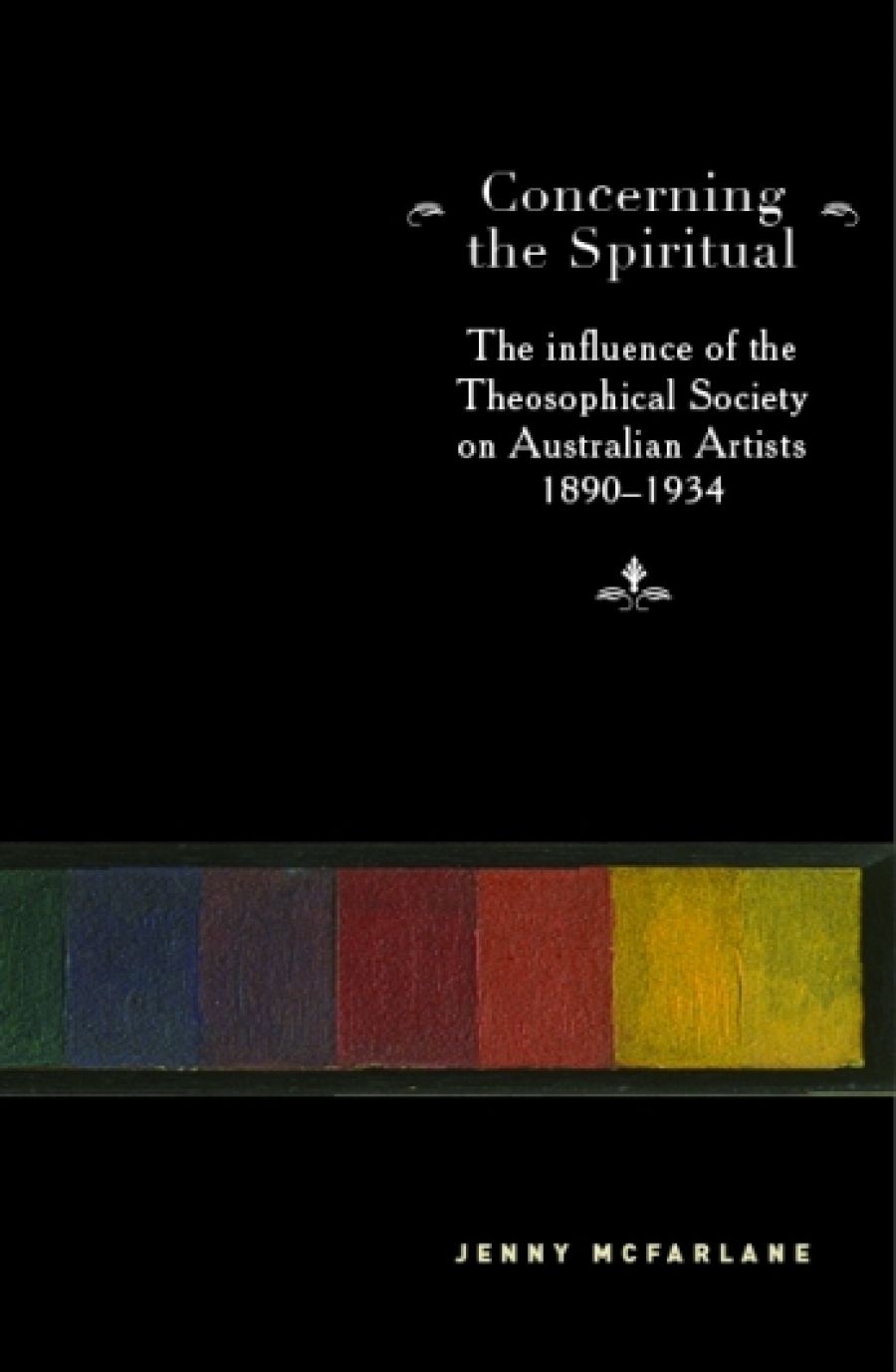
- Free Article: No
- Contents Category: Art
- Review Article: Yes
- Online Only: No
- Custom Highlight Text:
Jenny McFarlane, in this fascinating study of Theosophical influences upon Australian artists, attempts a ‘cross-cultural and interdisciplinary interrogation of modernity’. Rather than viewing modernism in the arts as the progression of a series of ‘isms’, leading by a linear narrative to abstraction, she presents a picture of multiple, interweaving modernisms. Her period of interest extends from the 1890s, when prominent Australians such as Alfred Deakin and Henry Parkes were enthralled by Annie Besant’s Australian lectures, through the early twentieth century, when many artists officially joined the Theosophical Society, to the Society’s decline after the death of C.W. Leadbeater in 1934. By focusing on the way Theosophy encouraged artists to probe the nature of the visible and invisible, McFarlane gives an account of Australian modernism that is ‘gendered, decentralised and alternative’.
- Book 1 Title: Concerning the Spiritual
- Book 1 Subtitle: The influence of the Theosophical Society on Australian Artists 1890–1934
- Book 1 Biblio: Australian Scholarly Publishing, $49.95 pb, 225 pp
This is done in a series of case studies. Some of the artists included – Clarice Beckett, Grace Cossington Smith, Roy de Maistre – will be familiar to readers; others are relatively unknown. Women feature prominently. Clarice Beckett questions the nature of vision and hints at an unseen dimension to the familiar, linking the concerns of both Max Meldrum and the Theosophists. Ethel Carrick’s works, so often overlooked in favour of her husband’s, are given new weight as artistic expressions of divine flux. McFarlane demonstrates why they were reviewed at the time by her fellow artist and Theosophist Alexander Colquhoun as ‘a reflection of the perpetual restlessness of living things’. Florence Fuller, in her seemingly conventional portraits, abandons a scientific and ocular approach to seeing in an attempt to record through the ‘third eye’. McFarlane is not concerned if Fuller succeeds in this attempt or whether the works look ‘modern’, as this alternative account of modernism is defined more ‘by its challenge to the hegemony of Western reason’ than by stylistic concerns.
McFarlane is probably right in asserting that Australian art history has proceeded largely from ‘an atheist position, with little time for spirituality, invisible worlds, free-wheeling esoteric intellectual speculation’. Alan McLeod’s influential book The Pattern of Australian Culture (1963) made the misleading claim that religion ‘has been singularly absent as a cultural force in Australia’. This was the prevalent orthodoxy of the time and ‘the artist with a mind to their reputation would have done well to keep silent on the subject of any involvement with the Theosophical Society’. With postmodernism, which has shown itself more open to questions of spirituality, ‘this reticence is only now breaking down’.
McFarlane’s book is part of a wide-ranging trend in scholarship that looks at the twentieth century and explores alternative and supplementary traditions of modernity. In music, for instance, it has long been claimed that the most significant developments of the period were the move towards atonality with Schoenberg or the reaction against this by composers such as Stravinsky who looked to pre-Romantic forms for inspiration. A parallel tradition of Theosophically inspired music, with Scriabin playing a key role, is now being given greater weight. The Australian composer and Theosophist Phyllis Campbell, in a manner not dissimilar to Ethel Carrick, aimed to create masses of spiritually significant vibrations.
A question that these alternate accounts of modernism often deliberately avoid is one of judgement and aesthetic worth. There are those who argue that artists such as Florence Fuller and Phyllis Campbell have been forgotten, not because of a narrow, linear understanding of the avant-garde, but because they deserve to be. No amount of revisionism will make them appear other than minor on the evidence of their work, notwithstanding how radical their artistic ideas and aims might have been. Fuller herself admitted that she had not succeeded in expressing the hidden inner life of her portrait sitters on canvas. Some of her contemporaries, with no particular interest in spirituality but greater technical ability, were arguably more successful in this. I finished McFarlane’s study not convinced that ‘many artists previously described as being peripheral or minor’ should now be repositioned as ‘central to the Australian experience’.
McFarlane’s enthusiasm for her subject also, on occasion, leads her to overstate her case. In this ‘decentralised’ account of modernity, she shows how Theosophical thought, which took a vigorous and early hold in Australia, gave artists a theoretical framework for modernist practice parallel or even prior to theories of modern art arriving from the cosmopolitan centres of Paris and London. Yet it is a big step from this to asserting that the centre of radical art from 1914 ‘was Theosophical Sydney’. Her rich exploration of Ethel Carrick’s work similarly did not need to be bolstered by what comes across as a subtle denigration of her husband’s achievement.
Concerning the Spiritual began as a doctoral thesis. McFarlane has made it into a very readable book. Only on a few occasions does it hint at its origins in the tortured world of academic writing. Were some Theosophists really resentful of the ‘phallocentrism’ of the Liberal Catholic Church, or were they simply protesting the way the church marginalised women, in contrast to their liberated place within Theosophy? Phallocentrism seems an unnecessary anachronism dragged in from the world of gender studies and Derrida. Yet these are minor criticisms of a book which is well written and well researched. This publication makes a valuable contribution to understanding the development of modern art in Australia, which, in the words of Basil Burdett, is like ‘the House of God, a house of many mansions’.


Comments powered by CComment